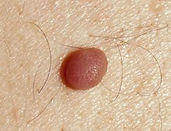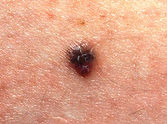
Moles
Most people have moles which do not bother them. An average adult would have between 10 to 30 moles with a typical size not exceeding half a centimeter. Most moles are not cancerous. They are benign tumours formed from clusters of melanocytes, the cells that are responsible for pigmentation. Moles tend to grow when the melanin cells proliferate, the process lasts a couple of years.

Moles can be flat or raised above the skin, light or dark in tone, with or without hairs. Typically, a clear edge marks the perimeter of the mole. The important thing is to keep an eye out for any changes. If a mole changes colour, turns crusty in appearance, begins to grow or becomes itchy, you should make an appointment with your doctor to evaluate it and to rule out skin cancer.
Scientists found that a mutation in a gene called BRAF was responsible for abnormal growth of melanocytes. Melanomas, the most dangerous form of skin cancer, are also originated from BRAF mutations and abnormal melanocyte growth. However, in nomal skin moles, cell proliferation stops at a certain point.
It has been a long-standing question in the field - why moles stop growing despite the BRAF gene's activity.
Researchers found that malignant moles have extremely high expression of a gene called p15 in comparison with the melanocytes from the normal skin (140 times higher). A recent study, published in the Cancer Discovery Journal, identified a major genetic factor that keeps moles in their usual non-cancerous, no-growth state. P15 protein acts as a brake in cell division, thus hindering the progression of a benign mole into malignant state.
(https://melanomanewstoday.com/2015/08/07/key-genetic-factor-controls-mole-development-melanoma/)
The BRAF mutation, that stimulates the initial growth of moles, is also responsible for the production of a tumour suppressor protein p15, which ultimately acts as a powerful brake on further cell division, thus keeping benign melanocytic naevi in a growth-arresting state. When mole cells lose the p15 brake, due to the mutation in BRAF, cells can start dividing again and can progress into cancer.

Benign

Malignant
Sun has been known to be a contributing factor in skin malignancy. Proliferation of melanocytes continues long after sun exposure. It is vital to use a good quality sun protection cream. Mineral based sun blocks do not get absorbed into your body, they stay on the surface of the skin. L-Formula has a specially designed 100% mineral sunscreen, called DV8.
It is a good practice is regularly examine yourself for any suspicious moles. There is a handy ABCDE Rule that can be applied.
Benign moles can be removed or greatly reduced using Advanced Electrolysis. Depending on its size and how well it is established, it may take more than one treatment. Removal of benign moles is considered to be a cosmetic procedure and is no longer available on NHS. Please note that your GP's consent is required for mole(s) removal.